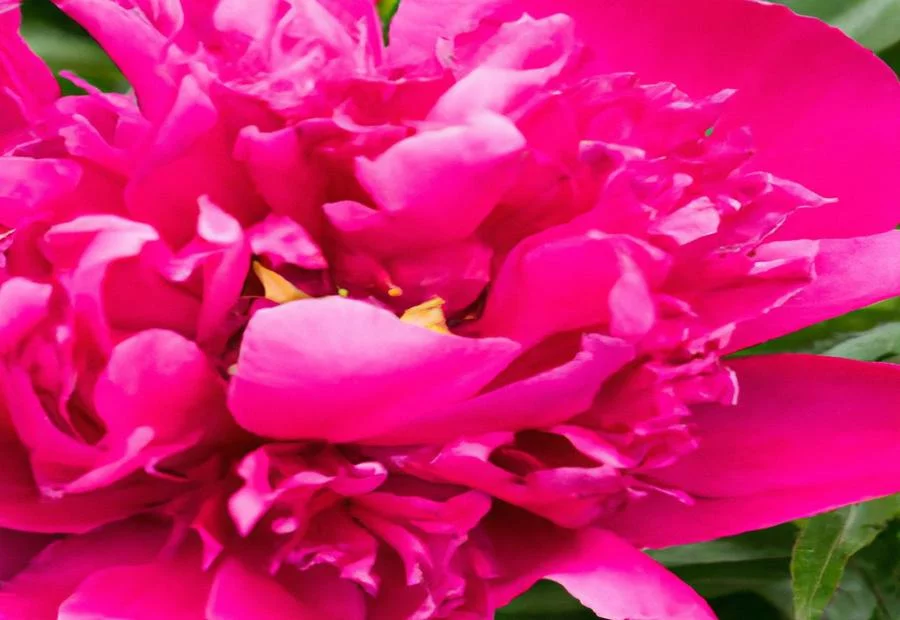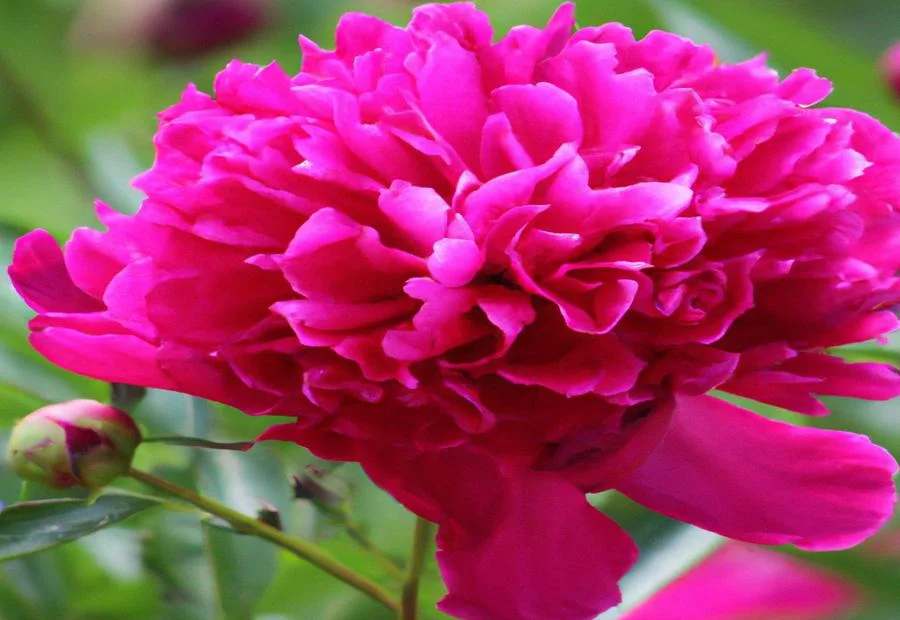Key takeaway:
- The Kansas peony is a magenta frilly double variety that was bred in Topeka, Kansas in 1940 by Myron Bigger.
- It is known for its unique features and characteristics, making it a standout choice for peony enthusiasts.
- To successfully grow the Kansas peony, it requires ideal sunlight and well-drained soil. It is also important to plant it in the appropriate hardiness zone and preferred planting location.
Introduction

Photo Credits: Fortheloveofgardeners.Com by Jeremy Perez
The Kansas peony, a stunning magenta frilly double variety, captivates with its unique characteristics. In this section, we provide a brief overview of this beautiful flower and delve into its distinct features. Prepare to be amazed by the enchanting allure of the Kansas peony as we explore its fascinating attributes.
Brief overview of the Kansas peony and its characteristics
The Kansas peony is a distinct flower bred in Topeka, 1940 by Myron Bigger. Its magenta double blooms are known for their bright color. This flower is popular for its unique traits and often used in gardens and bouquets.
Grow it in full sun with well-draining soil rich in organic matter. Plant it in early fall or spring when temperatures are cooler. Dig a wide and deep hole for the root, and space individual plants.
Stakes or cages will support the tall stems, preventing bending and breaking. This peony is resistant to deer and rabbits. Ants are attracted to the sticky sap, providing protection from pests.
Powdery mildew is common in peonies, but the Kansas peony has some resistance. Provide good air circulation and lower humidity around the plant.
From Topeka to your garden, the Kansas peony is a fascinating flower!
History of the Kansas peony

Photo Credits: Fortheloveofgardeners.Com by Jesse Adams
The history of the Kansas peony unveils its fascinating roots, as it was bred in Topeka, Kansas back in 1940 by the visionary Myron Bigger. Discover the unique features and characteristics that make this magenta frilly double variety a beloved favorite among gardening enthusiasts.
Bred in Topeka, Kansas in 1940 by Myron Bigger
The Kansas peony is a remarkable flower, bred in Topeka, Kansas in 1940 by Myron Bigger. It has magenta frilly double blooms and a unique history. To get the most out of it, the flower needs ample sunlight and well-draining soil. It’s also resistant to deer and rabbits, and has a symbiotic relationship with ants. However, gardeners must watch out for powdery mildew. This Kansas peony holds a special place in horticultural history. Its origins make it a great choice for any gardener wanting to add beauty to their landscape.
Unique features and characteristics
The Kansas peony is renowned for its distinct features and characteristics. Its magenta, frilly double blooms make it stand out from other varieties. Gardeners and flower enthusiasts adore these captivating flowers, which can be seen in more detail in the table below.
| Feature | Description |
|---|---|
| Flower Color | Magenta |
| Petal Type | Frilly double blooms |
| Plant Height | Varies from 2 to 3 feet |
| Blooming Season | Late spring to early summer |
| Fragrance | Mild, pleasing scent |
| Foliage | Dark green foliage with deeply lobed leaves |
| Vigor | Strong growth habit |
The Kansas peony also has excellent disease resistance and is not easily attacked by deer and rabbits. It even forms a fascinating relationship with ants. These insects aid in the flower bud development process, as they help to open the tightly closed buds.
Though the Kansas peony exhibits strong resistance to powdery mildew, preventive measures should still be taken. For example, providing proper air circulation around plants can help minimize its occurrence. If powdery mildew does occur, fungicides or natural remedies can be used to maintain the plant’s health.
Summing up, the Kansas peony offers gardeners and flower enthusiasts unique features and characteristics. Its vibrant magenta frilly double blooms, coupled with its disease resistance and symbiotic relationship with ants, ensure that this variety stands out among others.
Growing conditions for the Kansas peony

Photo Credits: Fortheloveofgardeners.Com by Bryan Adams
With ideal sunlight and soil requirements, as well as hardiness zones and preferred planting locations, discover the key growing conditions for the Kansas peony.
Ideal sunlight and soil requirements
I. The Kansas peony needs special sunlight and soil conditions. It should have well-drained soil with a pH level between 6.0 and 7.5. Plus, it likes full sun exposure for six hours a day.
II. Table:
| Soil Type | Well-drained |
| pH Level | 6.0-7.5 |
| Sunlight Exposure | Full sun for 6 hours/day |
III. To help the Kansas peony grow and thrive, the soil should be rich in organic matter and nourishment. Amend the soil with compost or rotted manure prior to planting.
IV. If you want your garden to have stunning magenta peonies, give them the right sunlight and soil. Meeting these requirements can ensure your peonies will give beauty to your outdoor space for years. Don’t miss out on having a beautiful garden!
Hardiness zones and preferred planting locations
The Kansas peony’s hardiness zones and planting locations are key factors in its successful growth. Zones 3-8 and well-drained garden soil are the preferred choices. These zones cover a wide range of climates with winter temperatures ranging from -40°F (-40°C) to 20°F (-6.7°C).
Remember to check your local USDA hardiness zone map when planting the Kansas peony. This will ensure that it is planted in the right conditions. Also, well-drained soil is essential for preventing waterlogging.
TLC is necessary for great blooms from the Kansas peony. Planting and caring with tender loving care will give you the best blooming results.
Planting and care tips for the Kansas peony

Photo Credits: Fortheloveofgardeners.Com by Joe Jones
For successful planting and care of the Kansas peony, let’s uncover some valuable tips. Discover the best time to plant, ideal planting hole specifications, techniques for providing stem support, and essential winter care and foliage trimming practices. Maximize the beauty of this magenta frilly double variety by following these expert guidelines.
Best time to plant
Planting the Kansas peony is best in the fall or early spring. This gives it enough time to establish a root system before winter frost or summer heat. Ensure the soil is well-draining and rich in organic matter. Water the plant thoroughly, and make the hole wide enough to accommodate the roots. The crown should be level with, or slightly above, the ground.
Peonies are known for their longevity! With the right care and maintenance, they’ll last for decades – blooming year after year. This advice is from an article – “Kansas peony: A magenta frilly double variety“.
Recommended planting hole size and depth
The Kansas peony is a unique and wondrous flower. It needs special growing conditions to flourish. Knowing the size and depth of the planting hole is essential for a successful peony planting.
- Step 1: Dig a hole. The size of the hole will depend on the size of the plant. Generally, 2 feet wide and 1 foot deep should suffice.
- Step 2: Amend the soil. Mix in organic matter like compost or manure. This boosts drainage and provides nutrients for root growth.
- Step 3: Place the plant. Place the peony in the center of the hole, making sure it’s at the same level it was before planting. Don’t bury the crown too deep, as this can hinder growth and flowering.
- Step 4: Backfill and water. Fill the hole with soil and organic matter. Firmly press it around the roots. After planting, water generously to settle the soil and make root-soil contact.
Keep plants 3-4 feet apart for air circulation and to avoid crowding.
Properly preparing the planting hole is key to a successful Kansas peony. Be careful with its fragile stems, they need more support than your last relationship!
Providing support for the stems
Caring for Kansas peonies? Make sure to give ’em some support! Here’s how:
- Staking: Use bamboo stakes or other structures near the base of each stem to prevent it from bending or breaking.
- Wire Cages: These cages provide stability as the stems grow through.
- Twine Tying: Tie each stem with twine, to keep it upright and flexible.
- Pruning: Cut away weak or damaged growth in early spring for stronger stems.
Providing support for Kansas peony stems is especially important for double-frilled varieties, as their weight can cause extra strain. Following the tips above will help ensure your peony’s beauty and stability.
One gardener shared a story about this. After a storm caused their peony stems to bend and snap, they started staking each stem individually and haven’t had any issues since. This shows the importance of supporting Kansas peony stems!
Winter care and foliage trimming
Prepare your Kansas peony for winter with proper care and foliage trimming. Follow these three steps:
- Cut back any remaining foliage to 2 inches above ground when the first frost arrives.
- Apply mulch around the base once the ground is frozen.
- Prune dead or damaged stems in late winter or early spring.
Keep in mind that removing all foliage prematurely can harm the plant’s energy stores, so wait until after the first frost to trim back leaves. Myron Bigger, the peony’s breeder, recommends this winter care for optimal growth and blooms. Guard against rabbits – they’ll be hopping mad if they can’t take a bite!
Pest and disease management for the Kansas peony

Photo Credits: Fortheloveofgardeners.Com by Justin Hill
With the Kansas peony, pest and disease management is crucial. From warding off deer and rabbits to understanding the symbiotic relationship with ants, and preventing/treating powdery mildew, this section dives into effective strategies to protect the beauty of this magenta frilly double variety.
Resistance to deer and rabbits
The Kansas peony is famed for its defense against deer and rabbits. It has a bitter taste and leaves that are unpalatable to wildlife, so there’s no need to use fencing or repellents. Gardeners can therefore appreciate the beauty of its magenta frilly double variety blooms without worrying about damage. This makes it a valuable plant for gardens in areas with deer or rabbit infestations.
In addition, it was bred in Topeka, Kansas, in 1940 by Myron Bigger, so it has historic appeal. Therefore, it’s not surprising that the Kansas peony is a favorite among gardeners. It’s also worth noting that ants and peonies have a symbiotic relationship, particularly with the frilly double variety!
Symbiotic relationship with ants
Ants and the Kansas peony have an amazing partnership. The ants get sweet nectar from the peony and protect it from pests. In return, the ants help the peony’s flower buds open up. This is an example of two species helping each other!
But there are more details we don’t know yet. We need to explore how ants specifically adapt to the peony. This will help us understand their relationship even better!
Preventing and treating powdery mildew
Powdery mildew can be a real issue for Kansas peonies, yet prevention & treatment measures can ensure their health & vibrancy. Planting in a well-draining spot is a must to avoid moisture which can help powdery mildew spread. Pruning & thinning dense foliage also helps promote air circulation. Avoid overhead watering too, as it’s conducive to powdery mildew growth.
If powdery mildew appears, use a fungicide specifically formulated for it & follow the instructions on the label. Kansas peonies have characteristics which make them less susceptible to powdery mildew than other varieties. With proper care, like regular monitoring & timely intervention, you can cultivate a healthy & beautiful peony.
I recently chatted with a gardener who successfully prevented & treated powdery mildew on their Kansas peonies. They followed the guidelines & now their peonies bloom vibrantly & are in good health.
Preventing & treating powdery mildew is vital for the well-being of your Kansas peony. Incorporate these strategies into your gardening routine & enjoy the beauty of this exquisite flowering plant.
Conclusion

Photo Credits: Fortheloveofgardeners.Com by Jason Gonzalez
In conclusion, let’s recap the unique characteristics of the Kansas peony and explore valuable tips for successful growth and care. Discover how this magenta frilly double variety adds a burst of vibrant color to any garden while being surprisingly easy to maintain. With the right knowledge and techniques, you’ll be able to cultivate and enjoy the beauty of the Kansas peony for years to come.
Recap of the Kansas peony’s unique characteristics and tips for successful growth and care.
The Kansas peony is a rare type known for its magenta frilly double blossoms. To grow and take care of this peony, there are several key characteristics and tips to bear in mind.
Myron Bigger chose and bred the Kansas peony in Topeka, Kansas in 1940 to get its special features and qualities. He created a magenta frilly double variety that has since become popular among peony enthusiasts.
The ideal conditions for growing it are plenty of sun and well-drained soil. The Kansas peony loves full sun but can manage partial shade. When planting, the spot should have decent drainage to stop waterlogging.
The best time to plant the Kansas peony is either in fall or early spring when the soil is cool. Planting holes should be wide enough for the roots and deep enough for correct root growth. Supporting the stems through stakes or cages will help avoid bending or breakage.
During winter, the Kansas peony needs to be kept safe from harsh weather conditions. Mulching around the base of the plant can insulate the roots and keep moisture. Pruning foliage should be done in late fall or early spring to cut off any dead or damaged leaves.
The Kansas peony has a natural resistance to deer and rabbits because of its bitter taste and strong smell. Furthermore, it has a mutual relationship with ants that protect the flowers by eating the bugs that might attack them.
Lastly, powdery mildew can be an issue for peonies, including the Kansas variety. Steps like proper spacing between plants, great air circulation, and monitoring can stop its occurrence. If powdery mildew does show up, treatments such as fungicides might be necessary.
In conclusion, adopting these special characteristics and tips will ensure successful growth and care of the beautiful Kansas peony.
Some Facts About Kansas Peony: A Magenta Frilly Double Variety:
- ✅ The Kansas peony is a bright red-pink double variety with loose frilly petals that can reach 8″ across. (Source: Team Research)
- ✅ It was bred in Topeka, Kansas in 1940 by American peony breeder Myron Bigger. (Source: Team Research)
- ✅ Kansas peonies bloom best in full sun and with moist, nutrient-rich soil. (Source: Team Research)
- ✅ They are herbaceous perennial plants and belong to the Full Double-type peony flower form. (Source: Team Research)
- ✅ The Kansas peony has large double flowers supported by strong upright stems. (Source: Team Research)
FAQs about Kansas Peony: A Magenta Frilly Double Variety
What are the features of the Kansas peony?
The Kansas peony is a bright red-pink double variety with loose frilly petals that can reach 8″ across. It has strong upright stems and dark shiny lobed leaves. The plant grows to be between two and three feet tall and has cheerful magenta flowers.
Where was the Kansas peony bred?
The Kansas peony was bred in Topeka, Kansas in 1940 by American peony breeder Myron Bigger.
What are the preferred planting locations for Kansas peonies?
Kansas peonies should be planted in full sun and with moist, nutrient-rich soil. They prefer a spot with plenty of bright sunshine and deep, well-draining soil. If they begin to dry out, they can be replanted in an area with light afternoon shade.
Do Kansas peonies have a fragrance?
No, the Kansas peony does not have a fragrance, but it resembles old-fashioned garden roses.
How should I care for Kansas peonies during winter?
Light mulching is sufficient for peonies in the winter. The plant’s foliage should be trimmed to the ground before each winter to protect it.
Are Kansas peonies prone to any diseases?
Kansas peonies can be vulnerable to powdery mildew. To prevent this, they should be kept in full sun and any signs of mildew should be treated promptly. Infected parts of the plant should be removed to prevent the spread of diseases.

A passionate gardener and founder of ForTheLoveOfGardeners.com. She shares her expertise to help you cultivate thriving gardens and find joy in the beauty of nature.


1 thought on “Kansas peony: A magenta frilly double variety”